#coal and iron ore
Explore tagged Tumblr posts
Text










Ore Creepers
this idea of creepers made out of ore kind of kicked in my brain- the way they would work is sort of similar to the classic elemental creepers mod, where they explode psychically but they turn stone/deepslate/netherrack/endstone into the ore they were made out of and killing them gives you some of the ore that they're made of. i'd love to ultimately expand this idea into modded ores
#creeper#minecraft#ore#coal#iron#gold#copper#redstone#lapis lazuli#diamond#emerald#nether#ancient debris#netherite#fanart#art#artists on tumblr#minecraft art#mineblr
50 notes
·
View notes
Text

integrated steel mill
43 notes
·
View notes
Text

god i love ! jsut looking over and seeibg the church. such a great build im so proud of it
#moth post#danny plays minecraft#thinking of making a building that would hold my irons and golds and other ores. and coal. god i have so much coal. im like overflowing at#this point. i need to fix the situation <3#like a forge or sth. idk what theyre called LOL
4 notes
·
View notes
Text
One very specific modern example of this is steelmaking technology and how it evolved with the exploration of iron. Nowadays, we have a capacity to take off a much higher percentage of impurities from iron ore, and to consume less coal to do it. That's great, right?
But it wouldn't have been worth it a hundred years ago because ores were richer in iron. Because we mined the easiest and richer iron ores, now we're left with ones that have less iron, and so we HAVE to find ways to be more efficient with it. If we installed all the modern technologies and requirements in 1910, it would first of all be a waste of energy because it already had more iron per ore than we do now, and would require higher quality metallurgical coal they couldn't identify or use to make better coke, and which would only be worth it for production of higher quantities of steel, which weren't used
This would only lead to piles and piles of useless but perhaps tougher steel, that no one had the means to know the quality of because fracture mechanics were only invented in the 40s
A historian or a sociologist will say something like “technology doesn’t exist on a simply hierarchy like in a video game,” and I think people whose exposure to history is primarily through pop culture will go “huh? that seems like nonsense. I mean, an automatic rifle beats a sword. 21st century America is richer than 3000 BC Mesopotamia. Our medical technology right now, today, is better than anything in the Middle Ages. Of course you can ‘rank’ technology!”
But the real answer is still no; because no technology exists apart from its context, and the question you are forgetting is–better how? Better in what situations?
The Ancient Greeks knew the principles necessary to build steam engines, and probably would perfectly understand the principle of operation of a steam locomotive; but they didn’t build trains, because they didn’t have the metals to build trains with, and they didn’t have the metals to build trains with because the economy of the ancient eastern Mediterranean didn’t support the manufacture of steel; and it didn’t support the manufacture of steel because bronze and the iron they had solved all the problems they needed metals for, a king of ancient Greece devoting his city-state’s spare productive capacity to mining iron ore and turning it into steel would have been wiped out by neighboring states who didn’t waste time and energy doing that, and spent their time making a bunch of bronze swords and beating the crap out of that king and his soldiers. Even if the Greeks could have built trains, what would they use them for? Railroads are a solution to transportation when you have industrial quantities of goods moving around to support a highly integrated economy, a rich source of high-carbon fuel easily available, and (for instance) warfare based on massive formations recruited from a mobilized, industrialized population.
None of which ancient Greece had. If you Connecticut-Yankee’d your way into 5th century BC Greece, you would find that trying to bootstrap an industrial economy from the ground up would require first speedrunning 2300 years of intervening demographic and economic developments, as well as technological ones, and even then a modern Greece surrounded by a Bronze Age world would be a very different animal, along all those dimensions, than a modern Greece surrounded by a modern world.
If you wanted to go Alexander with modern combined arms tactics and maneuver warfare, you could–but modern combined arms tactics and maneuver warfare is a solution to modern arms, and you might find it was significantly cheaper to arm your hoplites with slightly upgraded versions of the old spear-and-shield, and invest all the materials and energy you would have spent on tanks in building up the wealth of your state–because remember, everything you spend on building a better tank you’re not spending on anything else. This is why German technical skill was a miserable failure in WW2–their overengineered bullshit was expensive, and for each fancy German tank they pumped out (from a much worse position resource-wise than the Allies), the Allies made many less fancy, good enough tanks, and the Nazis got overrun. To recall the earlier metaphor: your automatic rifle is only any good if the other guy is way over there. If he sneaks up on you with his sword, you might wish you had a sword instead, though that won’t help you if you’ve only ever practiced using a rifle, because it’s “better.”
Even the process of innovation is not like most people imagine it, I would argue. The bulk of innovation comes from incremential trial-and-error improvements in processes that accumulate over decades, if not centuries or millennia. Incremential improvement is hard; unless you have a wild overabundance of resources, too much experimentation is just going to waste scarce materials; the thing that drives major innovations is having a problem that needs solving, and (again, until a resource becomes superabundant) a reliable method that produces consistent results is better than wasting time and effort testing a new way of producing something that may or may not work.
If you want an antibiotic or to send a message across the world, or figure out what the Moon is made of, yes, modern technology is better for all those things; and there are periods of cultural and societal change that open up the space for innovations: the steam locomotive was impossible in 5th century BC Greece, and inevitable in 19th century Britain. But it only became inevitable because of economic changes that only became inevitable because of demographic changes that started much earlier; those in turn were dependent on factors beyond the control of any single person or state.
Technologies can be dependent on each other, or on other factors, in the way living organisms are dependent on each other or on environmental factors in a food web; but a shark isn’t “better” than a jellyfish because it has a more complicated anatomy. It’s solving the problem of how to be a shark, while the jellyfish is solving the problem of how to be a jellyfish. Even our industrial, “scientific” technologies can struggle in environments they’re not suited for, which more “primitive” technologies do perfectly well in–because even our best technology (and our best scientists) are constrained by the environments and assumptions they are developed in.
#this is. very broad and has some generalisations to simplify and not be overly technical#of course modern steels would be great for the time and would possibly avoid some problems and accidents#but i don't think they'd be able to use them because characterisation equipment and methodology wasn't all there yet#it would be a waste of energy because they already had more iron at the time#and they didn't need that much steel#they wouldn't be able to tell which coal was better for making coke with as much accuracy not only because of characterisation equipment#but because nobody knew what happened inside a blast furnace because the first bf dissection was like in the 50s#because their instruments weren't strong enough to get in there because the steel wasn't good enough!!#so yeah it has to go inch by inch or else we wouldn't even be able to measure things much less use them with certainty#process and quality control have to evolve together with production or else it's useless#sorry for the long answer but i think it's fascinating that because we explored so much iron now ores have less iron#so we have to evolve our technologies to deal with that
16K notes
·
View notes
Text
NIT Jamshedpur Hosts National Workshop on Advances in Mineral Processing
Week-long training on iron ore and coal mineral processing concludes with insightful discussions and certificate distribution. The Metallurgical and Materials Engineering Department of NIT Jamshedpur concluded its week-long short-term training and national workshop on "Advances in Mineral Processing Techniques with Special Reference to Iron Ore and Coal (AMPTIC-24)" today. JAMSHEDPUR – NIT…
#AMPTIC-24#शिक्षा#coal#Dr. Anoop Kumar#Dr. Reena Sahu#education#iron ore#Jamshedpur News#Mineral Processing#national workshop#NIT Jamshedpur#Prof. Ram Vinay Sharma#Tata Steel
0 notes
Text
Not good at any other kind of mathematics, but because I play Minecraft semi-regularly and I like to maximize my efficiency and resource management, I know every multiple of four.
#It’s because a single lump of coal smelts up to eight items and I don’t like wasting coal on something stupid like two iron ore#And I also like building really complex shit in Survival mode and I need to keep track of my resources#My fucking post
1 note
·
View note
Text
0 notes
Text
Thinking that countries can run on breezes is worse than delusional.
A two-megawatt windmill is made up of 260 tons of steel that required 300 tons of iron ore and 170 tons of coking coal, all mined, transported and produced by hydrocarbons.
They each consume 10'000 liters (more than 2600 gallons) of crude oil based lubricants per year.
When outdated, the wind turbines are being buried deep in forests, out of public view, due to the high costs associated with recycling them.
A windmill could spin until it falls apart and it will NEVER, EVER generate as much energy as was used in building it. 🤔
#pay attention#educate yourselves#educate yourself#knowledge is power#reeducate yourself#reeducate yourselves#think about it#think for yourselves#think for yourself#do your homework#do your own research#do your research#do some research#ask yourself questions#question everything#wind turbines#green new deal#lies#climate change#climate crisis#government corruption#lies exposed#news
853 notes
·
View notes
Text








got bored. here's minecraft ores
in order: coal, iron, gold, redstone, lapis, emerald, copper, diamond
1K notes
·
View notes
Text
The Peaks Resound, Golden Veins Gleaming

"Hey there, Xilonen! So, about the sunglasses you made me last time... Got a couple of details I'd like to adjust, especially with the temple tip patterning... Hmm? Where'd she go? It's not even time for her lunch break yet... Hey! Xilonen! You there? C'mon, let's go over the particulars of the glasses manufacturing process again—"
—Thus exclaimed Mavuika at a high volume in front of Xilonen's workshop
◆ Xilonen
◆ Ardent Flames Forge the Soul
◆ Nanatzcayan Smith
◆ Vision: Geo
◆ Constellation: Panthera Ocelota

Xilonen's skill with the forge is renowned throughout Natlan.
Many come from far and wide to pay homage to her superb skill. Some hope to commission her to forge them weapons, while others only seek to see the visage of this great smith, such that they might have information of great interest to talk about.
But Xilonen couldn't care less about what all her customers are thinking. No matter what kind of ridiculous, fancy titles others give her, before all the honors and accolades, she is first and foremost an artisan. All she need do is refine the ore, and surely and steadfastly hammer it into its final shape one blow at a time, in accordance with the customer's requirements.
Reputation will not strengthen the blows of her hammer upon the anvil, nor will slander cool the coals of her furnace.
However, when a customer steps into her workshop, it is not the heat of the furnace that welcomes them, but rather a long form filled with blanks needing to be filled in.
"I'm happy to take the commission. But first, we need to iron out the details."
"Effective communication means efficient work. Come on, let's talk about just what you want."

#genshin impact#genshin impact updates#genshin impact news#official#xilonen#ohhh she's an ocelot...#only one new character though...
615 notes
·
View notes
Text
#Mining Shovel Market Current Scenario and Industry Growth Forecast with Major Key Players data by 2032#The global mining shovel market is estimated to create an absolute dollar opportunity of over US$ 10 Bn by the end of 2032. The sales of mi#exhibiting growth at 2% to 3% CAGR during the forecast period 2022-2032. Increasing emphasis on the development and introduction of advance#Mining shovels are mostly electric powered#and are primarily utilized for digging and loading earth#and for the extraction of minerals. Mining shovels are utilized in the surface mining of gold#copper#coal#and other commodities across the globe. Mining shovels are available in a wide range of payload capacities all over the world. They are des#Due to the rapid industrialization of emerging economies#particularly China and India#there has been significant growth in the demand for mined resources such as coal#iron ore#etc. Thus#it is anticipated that the demand for mining shovels will increase in the near future.#To Know more@#https://www.futuremarketinsights.com/reports/mining-shovel-market
0 notes
Note
Could you write one about Schlatt and (streamer)reader meeting on the sdmp?? Maybe they met before years ago like 2020 but their friendship sort of fizzled out?idk
have a nice day🧚♀️💝
believe it or not i haven't caught up with sdmp EEK but i will i swear; i've only watched like the first stream and then other clips on tiktok, heres what I came up with!

jschlatt x streamer!reader headcannons
warnings: nothing crazy i don't think, schlatt's online persona
a/n: listen bro i dont really know what im talking about im doing my best, i made it headcannons because i can't write in-game content 😔

⚜ you received an invite to a new minecraft server, one ran by the Sleep Deprived podcast members.
⚜ the last server you were in... yeah, we won't talk about that. you had left it suddenly, and no longer associate yourself and your content with specific people. a few exceptions were tommyinnit, tubbo, and technically jschlatt, although it had been a while since you actually made any content together.
⚜ when you first joined, you met so many new faces and reconnected with a few old ones. or at least tried to. schlatt wouldn't let anyone even near his property, so you couldn't really have a conversation with him without him hitting you or banning you.
⚜ you had made it a mission to yourself, and even a prediction in your twitch chat that you would get schlatt to allow you onto his very special property.
⚜ clearly, we've all seen what happens when you're too loud near his property or if you enter it without his permission. you didn't want to end up like one of them
⚜ you knew schlatt had a very pretty view over the ocean on his property, and even a tiny beach area, and you wanted in, and you also may have had a small crush on him back in the day, so you and your chat made a plan.
⚜ it started with leaving small objects in front of his fence, or putting them in a chest with a sign that said 'for schlatt.'
⚜ you would leave him flowers, some things that you had heard him asking other people for, food, coal, iron ore, anything.
⚜ you had noticed him asking around for who left it, but no one had figured that it was you, so you continued.
⚜ you started leaving larger objects, like already crafted objects, and started sending him letters.
⚜ you sent him a letter, saying 'meet me at spawn tonight. :p'
⚜ once he arrived, he was incredibly skeptical, so you gave him your proposal.
⚜ "listen, schlatt," you start. "i have a proposal. if you let me live on your land, i'll continue to supply you with all of the goods i get. what's mine is yours, if what's yours is mine."
⚜ "hm," he ponders. "i'll think about it."
⚜ he grants you small things from then on, like you're allowed to come into his property, but not yet live. you build a house fairly close to his fence, and place shared chests where you store things that you find.

this was straight dookie my bad anon
requests still open!
© property of xoxoluka. do not repost.
#jschlatt#jschlatt x reader#jschlatt x y/n#jschlatt x you#schlatt x reader#schlatt x y/n#schlatt x you#schlatt fanfic#schlatt#jschlatt fanfic
204 notes
·
View notes
Text
Cold Iron in folklore, fiction, and RPGs
'Gold is for the mistress—silver for the maid! Copper for the craftsman cunning at his trade.' 'Good!' said the Baron, sitting in his hall, 'But Iron—Cold Iron—is master of them all!' — Rudyard Kipling, “Cold Iron”
Folklore

Drudenmesser, or "witch-knife", an apotropaic folding knife from Germany
The notion that iron (or steel) can ward against evil spirits, witches, fairies, etc is very widespread in folklore. You hang a horseshoe over your threshold to deny entry to evil spirits, you carry an iron tool with you to make sure devils won't assault you, you place a small knife under the baby's crib to ward it from witches, and so on. Iron is apotropaic in many many cultures.
In English, we often come across passages that refer to apotropaic cold iron (or cold steel). "All uncouth, unknown Wights are terrifyed by nothing earthly so much as by cold Iron", says Robert Kirk in 1691, which I believe is the earliest example. "Evil spirits cannot bear the touch of cold steel. Iron, or preferably steel, in any form is a protection", says John Gregorson Campbell in 1901.
Words
So what is cold iron? In this context, it’s just iron. The “cold” part is poetic, especially – but not only – if we’re talking about either blades (or swords, weapons, the force of arms) or manacles and the like. It just sounds more ominous. There are “cold yron chaines” in The Fairie Queene (1596), and a 1638 book of travels tells us that a Georgian general (in the Caucasus) vowed “to make the Turk to eat cold iron”.
Green’s Dictionary of Slang defines “cold iron” as a sword, and dates the term to 1698. From 1725 it appears in Cant dictionaries (could this sense be thieves’ cant, originally? why not, plenty of words and expressions started as underworld slang and then entered the mainstream), and from ~1750 its use becomes much more common.
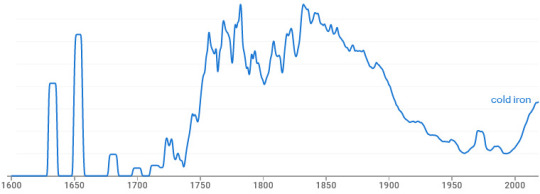
NGram Viewer diagram for 1600-2019.
In other contexts, cold iron is (surprise!) iron that’s not hot. So let’s talk a bit about metallurgy.
Metals
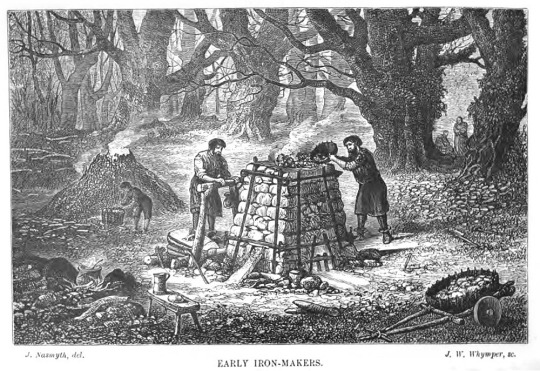
In nature, we can find only one kind of iron that’s pure enough to work with: meteoritic iron. It has to literally fall from the sky. Barring that very rare occurrence, people have to mine the earth for iron ore, which is not workable as is. To separate the iron from the ore we have to smelt it, and for that we need heat, in the form of hot charcoals. Throwing the ore on the coals won’t do much of anything, it’s not hot enough. But if we enclose the coals in a little tower built of clay, leaving holes for air flow, the temperature rises enough to smelt the ore. That’s called a bloomery.
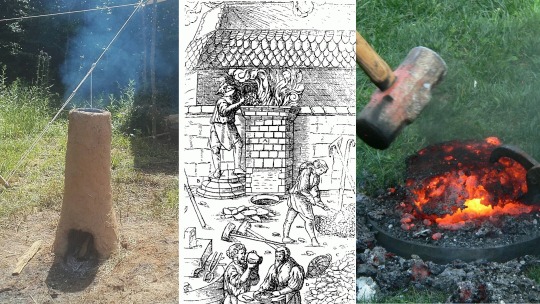
clay bloomery / medieval bloomery / beating the bloom to get rid of the slag
What comes out of the bloomery is a bloom: a porous, malleable mass of iron (that we need) and slag (byproducts that we don’t need). But now we can get rid of the slag and turn the porous mass to something solid, by hammering the hot bloom over and over. And once the slag is off, by the same process we can give it a desired shape in the forge, reheating it as needed. This is called “working” the iron, hence “wrought iron” objects, i.e. forged.
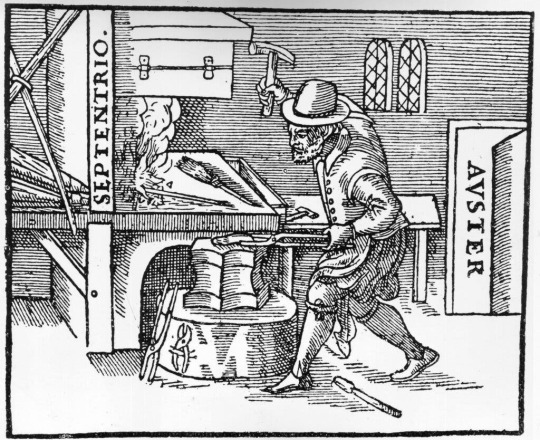
a blacksmith in his forge, with bellows, fire, and anvil (English woodcut, 1603)
This is the lowest-tech version, possibly going back to ~2000 BCE in Nigeria. If we add bellows, the improved air flow will raise the temperature. So smelting happens faster and more efficiently in the bloomery, and so does heating the iron in the forge, making it easier to work with. And that’s the standard process from the Iron Age all through the middle ages and beyond (although in China they may have skipped this stage and gone straight to the next one).
If we make the bloomery bigger and bigger, with stronger and stronger bellows, we end up with a blast furnace, a construction so efficient that the temperature outright melts the iron, and it’s liquified enough to be poured into a mould and acquire the desired shape when it cools off. This is “cast iron”.

a blast furnace
So in all of this, what’s cold iron? Well, it’s iron that went though the heat and cooled off. (No heat = no iron, all you got is ore.) If it came out of a bloomery, or if it wasn’t cast, it’s by definition worked, hammered, beaten, wrought, and that happened while it was still hot.
Is there such a thing as “cold-wrought” iron? No. In fact, “working cold iron” was a simile for something foolish or pointless. A smith who beats cold iron instead of putting it in the fire shows folly, says a 1694 book on religion, so you too should choose your best tools, piety and good decorum, to educate your children and servants, instead of beating them. When Don Quixote (1605) declares he’ll go knight-erranting again, Sancho Panza tries to dissuade him, but it’s like “preaching in the desert and hammering on cold iron” (a direct translation of martillar en hierro frío).
Minor work can be done on cold iron. A 1710 dictionary of technical terms tells us that a rivetting-hammer is “chiefly used for rivetting or setting straight cold iron, or for crooking of small work; but ’tis seldom used at the forge”. Fully fashioning an object out of cold iron is not a real process – though a 1659 History of the World would claim that in Arabia it’s so hot that “smiths work nails and horseshoes out of cold iron, softened only by the vigorous heat of the sun, and the hard hammering of hands on the anvil”. [I declare myself unqualified to judge the veracity of this statement, let's just say I have doubts.] And there is of course such a thing as “cold wrought-iron”, as in wrought iron after it’s cooled off.
Either way, in the context of pre-20th century English texts which refer to apotropaic “cold iron”, it’s definitely not “cold-wrought”, or meteoritic, or a special alloy of any kind. It’s just iron.
Fiction
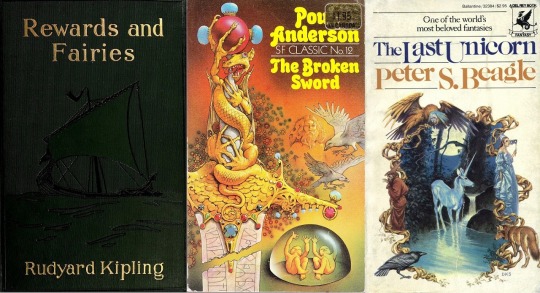
The old superstition kept coming up in fantasy fiction. In 1910 Rudyard Kipling wrote the very influential short story “Cold Iron” (in the collection Rewards and Fairies), where he explains invents the details of the fairies’ aversion to iron. They can’t bewitch a child wearing boots, because the boots have nails in the soles. They can’t pass under a doorway guarded by a horseshoe, but they can slip through the backdoor that people neglected to guard. Mortals live “on the near side of Cold Iron”, because there’s iron in every house, while fairies live “on the far side of Cold Iron”, and want nothing to do with it. And changelings brought up by fairies will go back to the world of mortals as soon they touch cold iron for the first time.
In Poul Anderson’s The Broken Sword (1954), we read:
“Let me tell you, boy, that you humans, weak and short-lived and unwitting, are nonetheless more strong than elves and trolls, aye, than giants and gods. And that you can touch cold iron is only one reason.”
In Peter S. Beagle’s The Last Unicorn (1968) the unicorn is imprisoned in an iron cage:
“She turned and turned in her prison, her body shrinking from the touch of the iron bars all around her. No creature of man’s night loves cold iron, and while the unicorn could endure its presence, the murderous smell of it seemed to turn her bones to sand and her blood to rain.”
Poul Anderson would come back to that idea in Operation Chaos (1971), where the worldbuilding’s premise is that magic and magical creatures have been reintroduced into the modern world, because a scientist “discovered he could degauss the effects of cold iron and release the goetic forces”. And that until then, they had been steadily declining, ever since the Iron Age came along.
There are a million examples, I’m just focusing on those that would have had a more direct influence on roleplaying games. However, I should note that all these say “cold iron” but mean “iron”. Yes, the fey call it cold, but they are a poetic bunch. You can’t expect Robin Goodfellow’s words to be pedestrian, now can you?
RPGs

And from there, fantasy roleplaying systems got the idea that Cold Iron is a special material that fey are vulnerable to. The term had been floating around since the early D&D days, but inconsistently, scattered in random sourcebooks, and not necessarily meaning anything else than iron. In 1st Edition’s Monster Manual (1977) it’s ghasts and quasits who are vulnerable to it, not any fey creature. Devils and/or fiends might dislike iron, powdered cold iron is a component in Magic Circle Against Evil, and “cold-wrought iron” makes a couple of appearances. For example, in AD&D it can strike Fool’s Gold and turn it back to its natural state, revealing the illusion.
Then Changeling: The Dreaming came along and made it a big deal, a fundamental rule, and an anathema to all fae:
Cold iron is the ultimate sign of Banality to changelings. ... Its presence makes changelings ill at ease, and cold iron weapons cause horrible, smoking wounds that rob changelings of Glamour and threaten their very existence.... The best way to think about cold iron is not as a thing, but as a process, a very low-tech process. It must be produced from iron ore over a charcoal fire. The resulting lump of black-gray material can then be forged (hammered) into useful shapes. — Changeling: The Dreaming (2nd Edition, 1997)
So now that we know how iron works, does that description make sense? Well, if we assume that the iron ore is unceremoniously dumped on coals, it does not. You can’t smelt iron like that. If we assume that a bloomery is involved even though it’s not mentioned, then yes, this is broadly speaking how iron’s been made since the Iron Age, and until blast furnaces came into the picture. But the World of Darkness isn’t a pseudo-medieval setting, it’s modern urban fantasy. So the implication here is that “cold iron” is iron made the old way: you can’t buy it in the store, someone has to replicate ye olde process and do the whole thing by hand. Now, this is NOT how the term “cold iron” has been used in real life or fiction thus far, but hey, fantasy games are allowed to invent things.
Regardless, 3.5 borrowed the idea, and for the first time D&D made this a core rule. Now most fey creatures had damage reduction and took less damage from weapons and natural attacks, unless the weapon was made of Cold Iron:
“This iron, mined deep underground, known for its effectiveness against fey creatures, is forged at a lower temperature to preserve its delicate properties.” — Player’s Handbook (3.5 Edition, 2003)
Pathfinder kept the rule, though 5e did not. And unlike Changeling, this definition left it somewhat ambiguous if we’re talking about a material with special composition (i.e. not iron) or made with a special process (i.e. iron but). The community was divided, threads were locked over this!
So until someone points me to new evidence, I’ll assume that the invention of cold iron as a special material, distinct from plain iron, should be attributed to TTRPGs.
#long post#cold iron#d&d#Changeling: The Dreaming#World of Darkness#Peter S. Beagle#The Last Unicorn#Rudyard Kipling#Poul Anderson#The Broken Sword#how to rogue#pathfinder#rogues in fiction#Operation Chaos#rogue superstitions#words of the trade#thieves' cant#ad&d#d&d history#1st edition#fey#3.5#fluff#trs
389 notes
·
View notes
Text
types of freight cars
made a whole post to help ppl design stex ocs as the resident freight enthusiast :) while this isn't every freight car in existence, it's definitely a good chunk of them!
FLATCARS
The most basic type of freight car. They’re…well…flat! Designed for carrying bulky loads.

Autorack: Transport automobiles. Can have single, double, or triple levels.
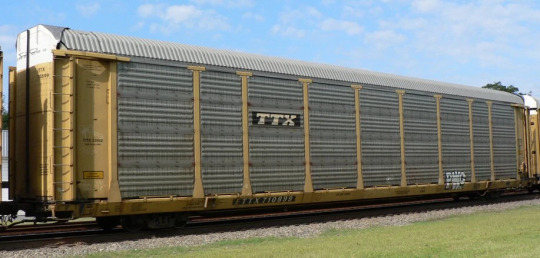
Boom/Idler: Placed in front of a breakdown crane to protect the boom or in front of/behind oversized loads to protect the overhang.
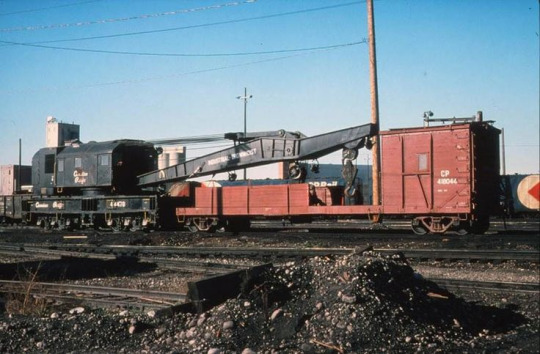
Bulkhead: Have walls (bulkheads) on the end. Used to transport pipe, poles, slabs, and lumber. Prone to derailing when traveling empty and put speed restrictions on the freight train.
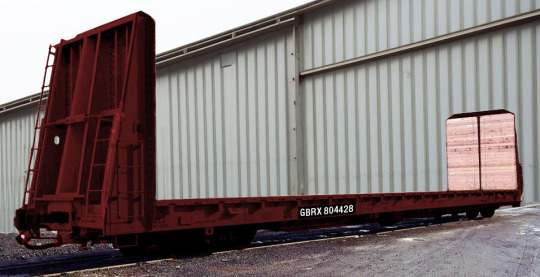
Centerbeam: Carry lumber. Another type is the opera (round) window style. Have to be loaded/unloaded evenly to avoid the car tipping over.

Depressed Center: Used to carry extremely heavy loads such as generators. Have a lowered (depressed) middle section.

Intermodal/Well: Carry semi-truck trailers and containers. Have a lowered bottom (well).

Skeleton/Spine: Very narrow car used to transport lumber. Has stakes on the sides. Spine cars do not have stakes and are often used for intermodal transport.

GONDOLAS
Open-topped cars that generally transport loose goods. Can also be covered. Differ from hoppers in that they have flat bottoms and have to be manually unloaded or put through a rotary dumper.
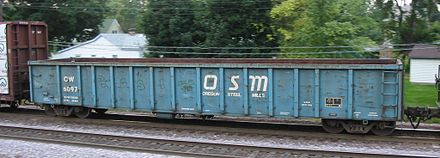
Bathtub: Transport coal. Have rounded bottoms for extra space.
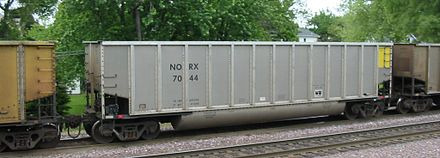
Coil: Carry coils of metal. Can be open or have specialized covers to protect the cargo. Typically considered a subtype of gondola, but can also be a subtype of flatcar as well.

Side-dump: Cars tip sideways to dump loads. Often carry ballast or rocks for railbeds.
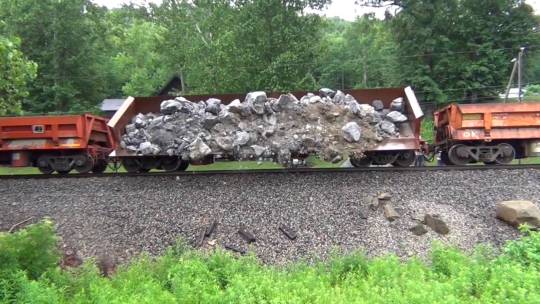
HOPPERS
Evolved from gondolas but differ in that they have sloped bottoms and discharge doors. Can be covered or uncovered, and have between two to five chutes. Open cars transport bulk goods such as coal, while covered ones carry food items.

Ore Jenny: A small, specialized hopper designed to carry large loads of iron ore from mines.
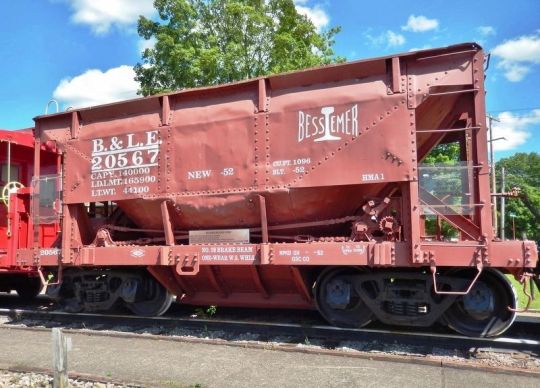
BOXCAR
Enclosed cars with side or end doors. Used for bulk commodities and for goods that need to be protected from the weather.
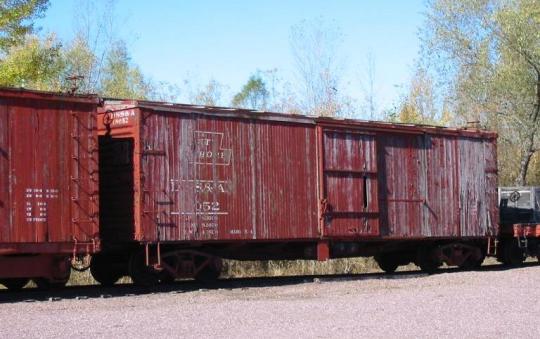
Stock: Used to transport livestock such as cattle, horses, sheep, and poultry. Have ventilated sides for airflow. A variant used to carry fish was attached to passenger trains and was more luxurious.
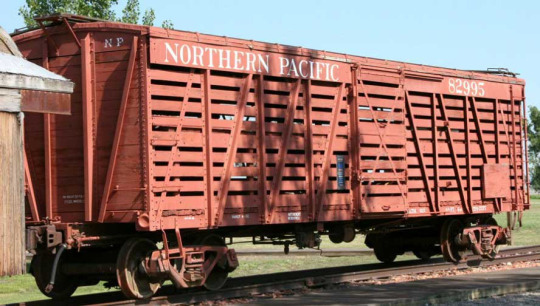
Refrigerator: Insulated and cooled cars used to transport frozen goods.

TANKERS
Used to transport liquids or gases. Can be specialized to carry hazardous materials.

Milk: Specialized tank car variant (as opposed to the boxcar variant) that carries milk. Attached to passenger trains to prevent spoilage.

Pickle: There's pickles in there! The vats were filled with vinegar.

Torpedo: Carry molten iron. Designed to withstand very high temperatures.

Whale Belly: Large tank car with a lowered midsection for additional carrying capacity.

SCHNABEL
These cars are a type all of their own. Used to transport extremely large loads by pinching it between the arms of the car.

93 notes
·
View notes
Text
Zimbabwe’s got itself a brand new iron and steel manufacturing plant, courtesy of the Chinese. This U.S. $1.5 billion Chinese-built plant’s blast furnace recently came online and is already producing pig iron, a crucial ingredient for making steel.
The team over at Dinson Iron and Steel Company (Disco), the Zimbabwean subsidiary of Chinese steel giant Tsingshan Holding Group, announced the production of their very first batch of pig iron on June 13. The Mvuma steel plant, situated about 120 miles south of Zimbabwe’s capital of Harare, is slated to be Africa’s largest integrated steelworks. According to a report in the South China Morning Post, it will also be one of Africa’s leading iron and steel producers.[...]
The Chinese firm plans to take things up a notch next month. That’s when the new steel manufacturing plant will start producing billets, the precursor to making steel. There are also plans to begin creating steel products like pipes, bolts, nuts, and even smaller slags, rolled tubes, fences, shafts, wires, and bars.
As part of the first production phase, the new plant recently set a target to make 600,000 tons of steel annually. Later, after the final phase, that production target grows to more than 5 million tons. The plant will also create jobs for the people of Zimbabwe. In the first phase alone, the new steel manufacturing facility hopes to employ around 2,000 people. This figure would double in the second phase. [...]
According to some experts, the steel plant could be a game-changer for Zimbabwe. The country has wanted to revive its iron and steel industry for a while now, especially after its largest steel plant shut down during the reign of ex-president Robert Mugabe.
In the coming years, the plant hopes to make use of Zimbabwe’s ample deposits of iron ore, chrome, coal, and more to produce iron and steel products that will strengthen the country’s value chain. Government officials recently stated that companies will mine and process these raw materials locally, with reserves projected to last for a whopping 100 years.
As a nation, Zimbabwe remains blessed with a wealth of natural resources like precious metals, nickel, ferroalloys and coking coal. According to analysts from inside and outside the country, these resources have the potential to help alleviate the country’s economic crisis.[...]
For over two decades, the U.S. and some European countries imposed sanctions on Zimbabwe. In March this year, the U.S., while terminating a Zimbabwe sanctions program, reimposed curbs on eleven individuals and three entities. This included the country’s president, Emmerson Mnangagwa, accused of human rights abuses, among other things. Chinese entities have capitalized on the situation by funding various projects in Zimbabwe, including dams, airports and a new parliament building.
Zimbabwe is also rich in lithium, a critical raw material for electric vehicle batteries. As a result, Chinese companies such as Zhejiang Huayou Cobalt and Sinomine Resource Group invested millions of dollars in acquiring lithium mines and over U.S.$1 billion in constructing processing plants.
12 Jul 24
66 notes
·
View notes
Text
0 notes